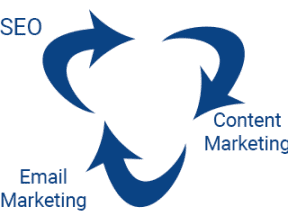Keyword research is the process of analyzing the search-engine queries of real people. That data — a window into the desires of searchers — is a gold mine for search engine optimization.
This post is the fourth installment in my “SEO How-to” series. “Part 1: Why Use It?” addresses the importance of search engine optimization to ecommerce. “Part 2: Understanding Search Engines” covers the basics of how search engines function. “Part 3: Strategy and Planning” explains how to set up your SEO program for success.
Keyword research is the SEO foundation for all of the content on your site. We can mine keyword data and then analyze it to understand how to fulfill searchers’ needs.
Keyword data consists of a word and a number. The example below, from Google Keyword Planner, shows how many times per month people search for keywords that are related to “book store.” The data pairs a specific word or phrase (such as “book store near me”) with a number (“301,000”), showing the average number of monthly U.S. searches in the last year.
| Keywords | Average Monthly Searches May 1, 2019 to April 30, 2020 |
|---|---|
| book store | 450,000 |
| amazon bookshop | 450,000 |
| book store near me | 301,000 |
| thrift store books | 165,000 |
| christian book store | 110,000 |
| bookstores near me | 90,500 |
| powells books | 90,500 |
| kids bookstore | 90,500 |
| used books | 74,000 |
| christian books | 74,000 |
| amazon books kindle | 74,000 |
| kindle bookstore | 74,000 |
| christian book store near me | 49,500 |
| used book stores near me | 49,500 |
| used book store | 49,500 |
| christian books distributors | 49,500 |
| book best sellers | 49,500 |
| kindle store | 33,100 |
| amazon books prime | 33,100 |
| strands bookstore | 33,100 |
All keyword research includes those two components: a keyword theme and the number of corresponding searches. Different keyword research tools also include other data fields, such as the estimated cost per click to advertise on that keyword theme and its level of competition.
Keywords and Themes
Search engines have moved beyond exact keywords to understand the nuances of human speech and intent. Keyword research mimics that evolution to some extent, merging data from variations in spelling and phrasing into a single keyword theme as opposed to individual words.
Most keyword tools organize data by themes. The number of searches for the keyword theme “book store,” for example, also includes searches for the plural form “book stores,” the single-word variant “bookstore,” and any popular misspellings or phrasings.
However, the keyword theme for “book store” in Google Keyword Planner does not aggregate the searches for other words in that dataset. Thus 301,000 searches for “book store near me” are not included in the 450,000 searches for “book store.” They are unique themes that reflect different searchers and their intent.
Keyword Research Tools
Google Keyword Planner is the leading source of keyword research. Google provides the tool for Google Ads’ customers, but it’s very useful for SEO, too. Its data represents 92 percent of all searches worldwide.
Still, like all datasets, the Keyword Planner has limitations that can influence your decisions, including:
- The data includes only Google searches.
- The data represents a single month averaged across the last 12 months in its initial dataset. Google does this to remove seasonality, but that means that there may be fewer or more searches in a specific month than the average number shown. However, the detailed monthly dataset is available to export.
- Keyword data is rounded to the nearest tens, hundreds, thousands, or millions, depending on the number.
- Unless you have access to a Google Ads account with a meaningful budget, your data will be lumped into brackets based on the number of searches, such as 1,000 – 10,000, making it impossible to determine the relative popularity of a keyword phrase within that bracket.
- Google provides the data to help sell advertising.
Thus, while keyword research is foundational to SEO, take the data as directional rather than absolute. We can assume that a keyword with 18,000 searches is more popular than one with 12,000, but small differences may be less reliable.
Microsoft Ads also offers a free keyword tool, but its dataset is much smaller since Bing represents only 3 percent of searches worldwide. And Bing’s users are typically older and more affluent.
Many of the major SEO tool platforms, such as seoClarity, BrightEdge, and Ahrefs, also include keyword research features. Their data comes from the Google Keyword Planner API, though they may use additional proprietary calculations.
Purchasing a license to one of these platforms is a way to get more accurate keyword data without having access to a Google Ads account. However, the cost is prohibitive if all you want is keywords since the platforms also include features such as organic rank tracking, predictive modeling, error checking, and SEO recommendations. A few, such as SEMrush, offer a limited free-trial version.
Other tools offer a non-numeric subclass of keyword data based on the autocomplete suggestions that Google and other search engines provide. While useful to generate ideas to plug into a numeric keyword research tool, suggestion-based tools don’t show the relative popularity of the words and phrases.
Consumer Research
Keyword research is an underutilized source of free consumer research. Consumers tell Google and other search engines what they want every day. Use that information. Examples include:
- New products to offer.
- New product features.
- Topics for FAQs or how-to guides or to lower customer support costs.
- Buyers’ guides and other supporting material to help drive sales.
- Content formats — such as videos and podcasts — to lure new customers to your site.
- New product filters to help shoppers navigate your site based on popular search attributes.




